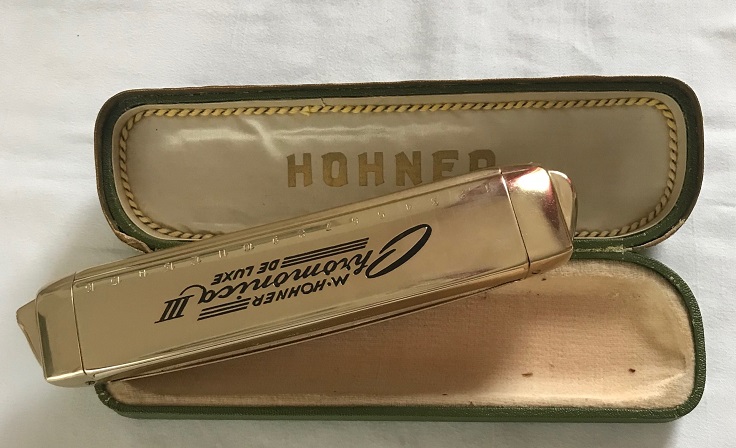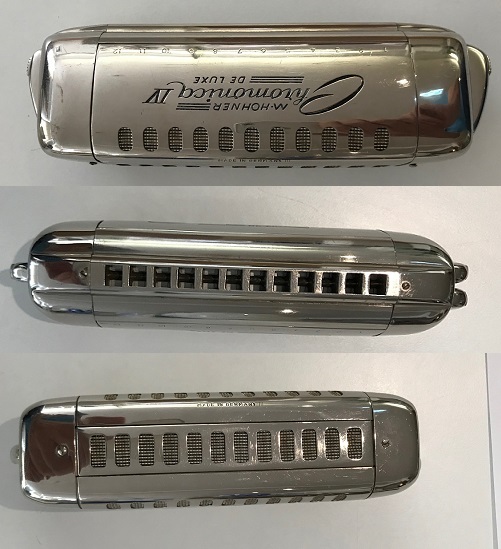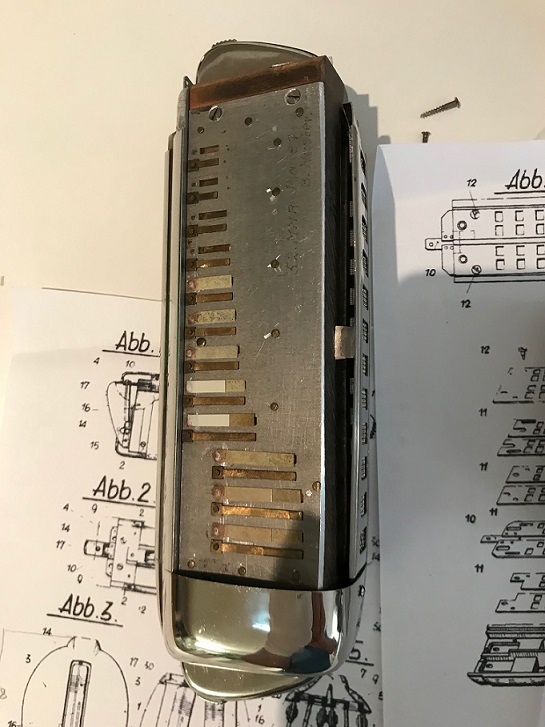At the beginning of the 1950s Hohner came out with two new models, a 10-hole Chromonica I De Luxe and a 12-hole Chromonica II De Luxe. The patent# 853853 was issued to Walter Hohner in 1952. More info can be found on Pat Missin’s website. As Pat mentions, the US Design Patent# 166750 was also issued to Walter Hohner the same year.
I’ve recently read an interesting article about John Vassos. Especially this part got my attention:
In the late 1940s, John Vassos was hired by Hohner to design harmonicas and accordions with his signature modernist and streamlined aesthetic, primarily aimed toward the American market. Vassos’ design drawings feature marks resembling air whooshing past his harmonicas—musical spacecraft traveling through the galaxy of his imagination.
I could actually imagine that John Vassos is the father of the Chromonica Deluxe design.






The Melodia II manufactured by the Czech company Lignatone might have taken some cues from the De Luxe chromatic.

Update:
I finally had the chance to go back to the harmonica museum in Trossingen to take a closer look at one of the most unique and stunning chromatic harmonicas out there, the Chromonica IV De Luxe. Martin Haeffner from the museum and Gerhard Mueller from Hohner were kind enough to allow me to spend some time analyzing and taking pictures of the instrument.

I’ve always wanted to get a deeper knowledge of that instrument. Maybe one day I will even be able to re-manufacture one.
According to its patent, it consists of two combs with two pairs of reed plates.
I was curious to find out how those different reed plates were tuned and how they interact with one another. I made a short recording carefully blowing into the instrument and utilizing all three buttons:
I quickly realized what was going on:
when blowing into one hole without using any buttons, one can hear two notes an octave apart.
E.g. when blowing into the first hole one will hear the middle C# and the C# one octave below. Contrary to a regular C tuned chromatic, one needs to press the right button in order to hear the middle C. Otherwise, the order of the notes is identical to a standard 3 octave C tuned chromatic.
The purpose of the two buttons on the left side is to allow for single note playing.
E.g. when only pushing the top left button and blowing into the first hole, the middle C# will play. When only pushing in the bottom left button the C# below middle C will play. This gives the De Luxe IV a range of 4 full octaves.

I was able to take off some of the outer covers to see more of the internal mechanism of the instrument.
Based on the fact that the reed plates are custom made and some scribbled notes on the reed plates, it was clear that this was the only prototype. Unfortunately, this instrument never went into mass production.
The De Luxe IV consists of many small parts interacting with each other, i.e. the locking mechanism of the left buttons. It was probably just too difficult to mass produce this instrument.

Beautiful pictures! How lucky you are to have a Deluxe III. I’ve seen a few of those online, before. The IV and mini versions are extremely cool and must be even more rare. Any idea of the chords offered on the IV? With double slides, it seems that it could be similar to the Hohner Chordomonica which probably wasn’t invented yet because Chamber Huang didn’t start working for them until later (?).
LikeLiked by 1 person
Actually, according to the patent there are 3 slides. One on the left and two on the right side. The one on the left switches the to either the top reed-plates (pair) or the lower ones. The slides on the right serve as regular half tone sliders. The patent does not mention any specific keys. I would assume the lower reed-plates are tuned in C- C# and the upper ones in G-G#. Similar to the double harmonicas.
LikeLike
I’ve seen other double-chromatic patents from the 1950s-60s, but not this one. Complicated! It has 5 Slider plates stacked up, which must have been very hard to get airtight with smooth movement. But with the angled comb bodies the distance from mouth to reeds is not too bad, so the Helmholtz Resonance Coupling issue probably was not excessive. I’d love to hear how it sounded – does anyone have one that still plays?
LikeLike
Hi Brendan, very cool to see you here. I only know of the one belonging to the Harmonica Museum in Trossingen. By chance, I will go there tomorrow. Maybe Martin let’s me try it out. If yes, I will make a recording and post it. BTW, do you have access to the other double-chromatic patents from the 1950s-60s. I would love to see them or if applicable even link them to my double-chromatic article.
LikeLike
Here’s one: https://patents.google.com/patent/US3149527A/en?oq=US+Patent+3149527+(A.+Kraft+1964) Quite similar to Walter Hohner’s design, but likely didn’t play very well because of the greater distance of mouth to reeds. After making quite a few custom DoubleChromatics of my own I know how problematic the issue of Helmholtz Resonance Coupling can be on the high range when the mouth-reed distance is increased.
LikeLiked by 1 person
You Sir – are a breath of fresh air – I’ve read your articles with great interest – in particular about the Hohner Chromonica ll which I once had (but then I sent in to Hohner for repairs and they informed me that it was not worth repairing and scrapped it! I was very annoyed! Now I’m trying find and buy another one!)
Your research is incredible – I wonder why Hohner did not continue with the production of such a beautiful piece?
Your thoughts about John Vassos seem to be bang on!
LikeLike